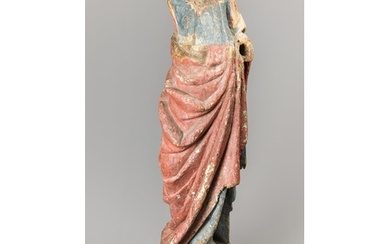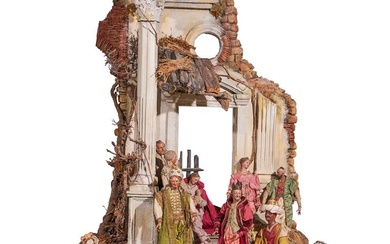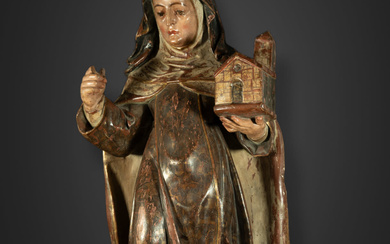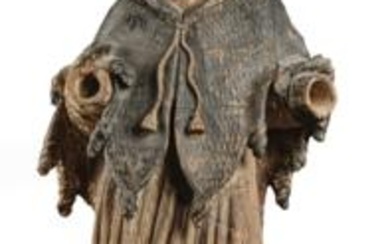A LARGE CARVED AND POLYCHROME PAINTED TOBACCONIST'S FIGURE, 17TH OR EARLY 18TH CENTURY
A LARGE CARVED AND POLYCHROME PAINTED TOBACCONIST'S FIGURE ALMOST CERTAINLY 17TH OR EARLY 18TH CENTURY91cm high, the base approximately 38cm diameterFor a related example see Edward H. Pinto, Treen and other Wooden Bygones, Bell and Hyman, London 1969. Page 412, plate 436.Originally this may well have been a tobacconist's shop window figure. For a similar, but slightly earlier unpainted example, see Sotheby's, The W. J. Shepherd collection of treen, 30th November 1983, Lot 393, illustrated in Pinto "Wooden Bygones of Smoking and Snuff Taking", plate 1.Carved wooden figures, often painted, were placed outside tobacconist's shops as signs from the 17th century onwards. The earliest of these figures is the 'black boy' or 'blackamoor'. 'At the sign of the black boy' or 'at the sign of the blackamoor' was a popular address for tobacconists since the early 17th century. The 17th century figures representing a 'pot-bellied native of Guinea", the figures developed during the 18th century, becoming progressively more refined. The instant example is unusually large in scale and is also unusual because it does not have a headdress. The features of the figure suggest that it is a 17th century example.
[ translate ]View it on
Sale price
Estimate
Time, Location
Auction House
A LARGE CARVED AND POLYCHROME PAINTED TOBACCONIST'S FIGURE ALMOST CERTAINLY 17TH OR EARLY 18TH CENTURY91cm high, the base approximately 38cm diameterFor a related example see Edward H. Pinto, Treen and other Wooden Bygones, Bell and Hyman, London 1969. Page 412, plate 436.Originally this may well have been a tobacconist's shop window figure. For a similar, but slightly earlier unpainted example, see Sotheby's, The W. J. Shepherd collection of treen, 30th November 1983, Lot 393, illustrated in Pinto "Wooden Bygones of Smoking and Snuff Taking", plate 1.Carved wooden figures, often painted, were placed outside tobacconist's shops as signs from the 17th century onwards. The earliest of these figures is the 'black boy' or 'blackamoor'. 'At the sign of the black boy' or 'at the sign of the blackamoor' was a popular address for tobacconists since the early 17th century. The 17th century figures representing a 'pot-bellied native of Guinea", the figures developed during the 18th century, becoming progressively more refined. The instant example is unusually large in scale and is also unusual because it does not have a headdress. The features of the figure suggest that it is a 17th century example.
[ translate ]






